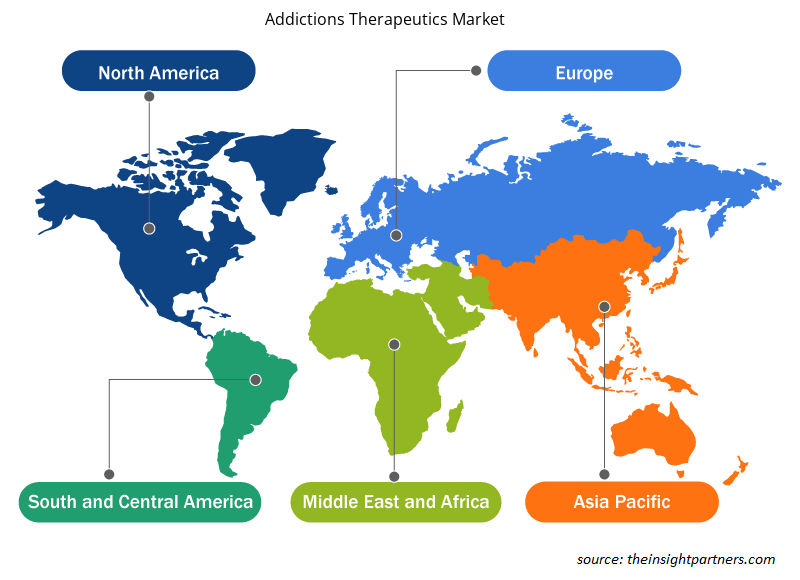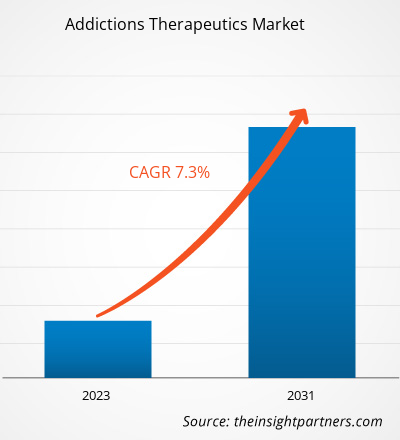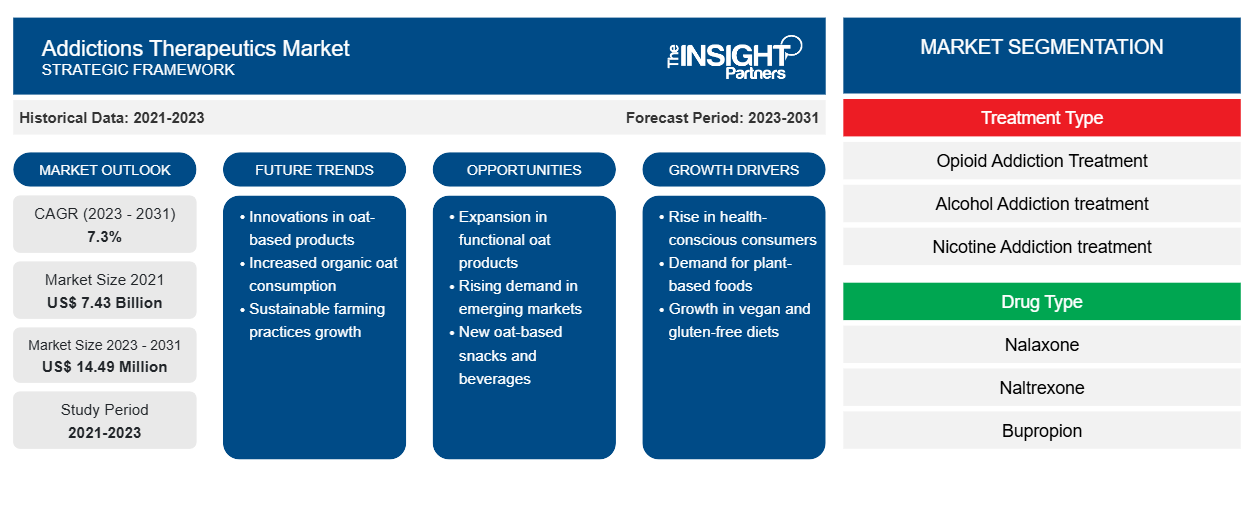Si stima che la dimensione del mercato delle terapie per le dipendenze sia stata di 7,43 miliardi di dollari USA nel 2021 e di XX milioni di dollari USA nel 2023 e si prevede che raggiungerà i 14,49 milioni di dollari USA entro il 2031; si stima che registrerà un CAGR del 7,3% fino al 2031. È probabile che il lancio coerente di varie terapie rimanga una tendenza chiave del mercato delle terapie per le dipendenze .
Analisi di mercato delle terapie per le dipendenze
I leader, i poteri governativi e le organizzazioni non governative (ONG) stanno cercando nuovi modi per creare consapevolezza e combattere l'epidemia della crescente dipendenza da sostanze. Ad esempio, il Council on Chemical Abuse partecipa a varie campagne statali e nazionali per aumentare la consapevolezza riguardo all'abuso di sostanze, al recupero e alla prevenzione.
L'Ufficio delle Nazioni Unite per la droga e il crimine (UNODC) guida una campagna mondiale che crea consapevolezza sulla sfida principale causata dalle droghe illecite alla società e alla popolazione giovane. L'UNODC intraprende varie attività di sensibilizzazione in tutto il mondo e invita individui, settore privato, organizzazioni non profit e stati membri a organizzare programmi di sensibilizzazione istituzionali contro il traffico illecito e l'abuso di droghe.
Inoltre, nell'agosto 2023, è stata lanciata in India una campagna per scoraggiare lo svapo tra gli adolescenti. La campagna mirava a raccomandare soluzioni efficaci e ha cercato l'aiuto di esperti per creare una comunicazione d'impatto che evidenziasse gli effetti negativi dello svapo. Inoltre, la campagna mirava a sensibilizzare sul divieto di svapo in India e in altri paesi, spiegando le ragioni alla base di tali misure.
È probabile che campagne di sensibilizzazione simili e sforzi governativi per contrastare l'abuso di droga e promuovere farmaci per liberarsi da ogni tipo di dipendenza alimenteranno la crescita del mercato durante il periodo di previsione.
Panoramica del mercato delle terapie per le dipendenze
Il mercato globale delle terapie per le dipendenze è segmentato per regione in Nord America, Europa, Asia Pacifico, Medio Oriente e Africa e Sud e Centro America. La regione del Nord America detiene la quota di mercato più grande del mercato, mentre la regione Asia Pacifico è la regione in più rapida crescita. La crescita del mercato in Nord America è dovuta principalmente all'ingresso di nuovi attori del mercato, al lancio di vari prodotti e al crescente numero di persone con una o più dipendenze da sostanze. Inoltre, l'Asia Pacifico è il mercato in più rapida crescita per le terapie per le dipendenze in uno scenario globale. Cina, India e Giappone sono i tre principali contributori alla crescita del mercato, che è guidato dall'elevata quantità di consumo di stupefacenti, dallo sviluppo in massa di farmaci generici per il trattamento delle dipendenze e dall'emergere di attori locali nella regione. Inoltre, anche gli investimenti in ricerca e sviluppo (R&S) da parte di aziende farmaceutiche multinazionali alimentano la crescita del mercato.
Personalizza questo report in base alle tue esigenze
Riceverai la personalizzazione gratuita di qualsiasi report, comprese parti di questo report, o analisi a livello nazionale, pacchetto dati Excel, oltre a usufruire di grandi offerte e sconti per start-up e università
-
Scopri le principali tendenze di mercato in questo rapporto.Questo campione GRATUITO includerà analisi di dati che spaziano dalle tendenze di mercato alle stime e alle previsioni.
Driver e opportunità del mercato delle terapie per le dipendenze
Crescenti partnership tra organizzazioni per favorire il mercato
Ci sono diverse organizzazioni nel mercato delle terapie per le dipendenze che collaborano e che stanno stimolando la crescita del mercato. Ad esempio, a settembre 2023, Click Therapeutics ha collaborato con Indivior. La collaborazione mira a sviluppare e commercializzare terapie digitali su prescrizione per trattare i disturbi da uso di sostanze, a partire dal disturbo da uso di oppioidi (OUD). La collaborazione sarà facilitata tramite un'applicazione mobile chiamata CT-102, che mira ad affrontare le principali lacune nell'OUD, come l'accesso a un trattamento psicosociale personalizzato e di alta qualità.
Allo stesso modo, nel gennaio 2023, Pear Therapeutics ha ampliato la sua partnership con le cliniche ambulatoriali per la cura delle dipendenze. Spero Health può ora utilizzare le terapie digitali su prescrizione reSET e reSET-O di Pear in 99 sedi in cinque stati, dopo averle utilizzate in precedenza in sole 14 cliniche nel Kentucky. Pertanto, le crescenti partnership tra organizzazioni guidano la crescita del mercato delle terapie per le dipendenze.
Crescente domanda di R&S da parte delle organizzazioni contrattuali: un’opportunità
Negli ultimi anni, l'industria farmaceutica ha assistito a una rapida crescita dei servizi di outsourcing; guidata da molti fattori, come la crescita della domanda di farmaci antidolorifici, l'aumento delle complessità delle API e la crescente necessità di ridurre i costi di sviluppo. Le grandi aziende farmaceutiche stanno esternalizzando le attività di R&S per aumentare la velocità del processo di sviluppo dei farmaci, oltre a ridurre i costi di sviluppo e produzione.
Diverse aziende farmaceutiche, tra cui quella che produce farmaci per la dipendenza, si affidano alle organizzazioni di ricerca a contratto (CRO) per ridurre al minimo gli elevati costi fissi di sviluppo interno, capacità di produzione e competenza. La crescente complessità nello sviluppo di nuove entità molecolari (NME) ha creato la necessità di capacità di nicchia che le aziende farmaceutiche preferiscono esternalizzare anziché internamente. Con l'aumento delle approvazioni dei farmaci (la FDA ha approvato 55 NME nel 2023); c'è un aumento dello sviluppo clinico robusto e della domanda di esternalizzazione. Diverse aziende biotecnologiche stanno sfruttando le CRO per espandere la pipeline dei loro potenziali farmaci candidati. La riduzione dei costi di produzione dei farmaci tramite l'outsourcing offrirà probabilmente significative opportunità di crescita agli operatori di mercato al fine di massimizzare i margini di profitto e sostenere il dinamico mercato dei farmaci per la dipendenza.
Analisi della segmentazione del rapporto di mercato sulle terapie per le dipendenze
I segmenti chiave che hanno contribuito alla derivazione dell'analisi di mercato delle terapie per le dipendenze sono il tipo di trattamento, il tipo di farmaco, il centro di trattamento e il canale di distribuzione.
- In base al tipo di trattamento, il mercato delle terapie per le dipendenze è segmentato in trattamento per la dipendenza da nicotina, trattamento per la dipendenza da alcol, trattamento per la dipendenza da oppioidi, trattamento per la dipendenza da altre sostanze. Il segmento del trattamento per la dipendenza da nicotina ha detenuto la quota di mercato maggiore nel 2023.
- Per tipo di farmaco, il mercato è segmentato in vareniclina, bupropione, prodotti sostitutivi della nicotina, buprenorfina, naltrexone, disulfiram, altri. Il segmento vareniclina ha detenuto la quota maggiore del mercato nel 2023.
- In termini di centro di trattamento, il mercato è segmentato in centro di trattamento ambulatoriale, centro di trattamento residenziale, centro di trattamento per pazienti ricoverati. Il segmento del centro di trattamento ambulatoriale ha dominato il mercato nel 2023.
Analisi della quota di mercato di Addictions Therapeutics per area geografica
L'ambito geografico del rapporto sul mercato delle terapie per le dipendenze è suddiviso principalmente in cinque regioni: Nord America, Asia Pacifico, Europa, Medio Oriente e Africa e Sud America/Sud e Centro America.
Il Nord America è il mercato più grande per la terapia delle dipendenze, con gli Stati Uniti che detengono la quota di mercato maggiore, seguiti dal Canada. La crescita in Nord America è caratterizzata dall'ingresso di nuovi attori del mercato, vari lanci di prodotti e un numero crescente di persone con una o più dipendenze da sostanze. Gli attori del mercato negli Stati Uniti raccolgono fondi per il trattamento delle dipendenze. Ad esempio, a luglio 2023, Affect Therapeutics, un'azienda che sta rivoluzionando il trattamento delle dipendenze utilizzando la tecnologia digitale, ha annunciato di aver raccolto 16 milioni di dollari in un round di finanziamento di serie A guidato da ARTIS Ventures, una società di investimento focalizzata su TechBio. I fondi raccolti saranno utilizzati per espandere i programmi dell'azienda a livello nazionale, nonché per migliorare l'app Affect attraverso l'innovazione ingegneristica.
Approfondimenti regionali sul mercato terapeutico delle dipendenze
Le tendenze regionali e i fattori che influenzano il mercato Addictions Therapeutics durante il periodo di previsione sono stati ampiamente spiegati dagli analisti di Insight Partners. Questa sezione discute anche i segmenti e la geografia del mercato Addictions Therapeutics in Nord America, Europa, Asia Pacifico, Medio Oriente e Africa e Sud e Centro America.

- Ottieni i dati specifici regionali per il mercato delle terapie per le dipendenze
Ambito del rapporto di mercato sulle dipendenze terapeutiche
| Attributo del report | Dettagli |
|---|---|
| Dimensioni del mercato nel 2021 | 7,43 miliardi di dollari USA |
| Dimensioni del mercato entro il 2031 | 14,49 milioni di dollari USA |
| CAGR globale (2023-2031) | 7,3% |
| Dati storici | 2021-2023 |
| Periodo di previsione | 2023-2031 |
| Segmenti coperti |
Per tipo di trattamento
|
| Regioni e Paesi coperti |
America del Nord
|
| Leader di mercato e profili aziendali chiave |
|
Densità degli attori del mercato terapeutico delle dipendenze: comprendere il suo impatto sulle dinamiche aziendali
Il mercato Addictions Therapeutics Market sta crescendo rapidamente, spinto dalla crescente domanda degli utenti finali dovuta a fattori quali l'evoluzione delle preferenze dei consumatori, i progressi tecnologici e una maggiore consapevolezza dei benefici del prodotto. Con l'aumento della domanda, le aziende stanno ampliando le loro offerte, innovando per soddisfare le esigenze dei consumatori e capitalizzando sulle tendenze emergenti, il che alimenta ulteriormente la crescita del mercato.
La densità degli operatori di mercato si riferisce alla distribuzione di aziende o società che operano in un particolare mercato o settore. Indica quanti concorrenti (operatori di mercato) sono presenti in un dato spazio di mercato in relazione alle sue dimensioni o al valore di mercato totale.
Le principali aziende che operano nel mercato della terapia delle dipendenze sono:
- PLC individuale
- Pfizer, Inc.
- Società per azioni GlaxoSmithKline
- Aziende sanitarie Bausch
- Cipla, Inc.
- Orexo AB
Disclaimer : le aziende elencate sopra non sono classificate secondo un ordine particolare.

- Ottieni la panoramica dei principali attori del mercato Addictions Therapeutics
Notizie e sviluppi recenti sul mercato delle terapie per le dipendenze
Il mercato delle terapie per le dipendenze viene valutato raccogliendo dati qualitativi e quantitativi post-ricerca primaria e secondaria, che includono importanti pubblicazioni aziendali, dati di associazioni e database. Di seguito è riportato un elenco degli sviluppi nel mercato delle terapie per le dipendenze:
- A gennaio 2023, Hikma Pharmaceuticals PLC ha lanciato Naloxone Hydrochloride Injection, USP, 2 mg/2 mL, in forma di siringa preriempita (PFS). Questo farmaco è utilizzato per il trattamento di emergenza di un sovradosaggio di oppioidi noto o sospetto ed è il terzo prodotto PFS lanciato. L'iniezione è attualmente disponibile negli Stati Uniti. (Fonte: Hikma Pharmaceuticals PLC, 2023)
- A gennaio 2022, Pfizer ha stretto una partnership con la start-up svedese Alex Therapeutics per avventurarsi nello spazio della terapia digitale. La piattaforma basata sull'intelligenza artificiale di Alex Therapeutics integra sia la terapia cognitivo-comportamentale (CBT) sia la terapia di accettazione e impegno (ACT) con l'intelligenza artificiale per personalizzare l'assistenza. L'obiettivo iniziale della loro partnership è creare una terapia digitale per il trattamento della dipendenza da nicotina e inizierà i suoi sforzi nel mercato tedesco. (Fonte: Pfizer, 2022)
Copertura e risultati del rapporto sul mercato delle terapie per le dipendenze
Il rapporto "Addictions Therapeutics Market Size and Forecast (2022–2030)" fornisce un'analisi dettagliata del mercato che copre le seguenti aree:
- Dimensioni e previsioni del mercato a livello globale, regionale e nazionale per tutti i segmenti di mercato chiave coperti dall'ambito
- Dinamiche di mercato come fattori trainanti, vincoli e opportunità chiave
- Principali tendenze future
- Analisi dettagliata delle cinque forze PEST/Porter e SWOT
- Analisi di mercato globale e regionale che copre le principali tendenze di mercato, i principali attori, le normative e gli sviluppi recenti del mercato
- Analisi del panorama industriale e della concorrenza che copre la concentrazione del mercato, l'analisi della mappa di calore, i principali attori e gli sviluppi recenti
- Profili aziendali dettagliati
- Analisi storica (2 anni), anno base, previsione (7 anni) con CAGR
- Analisi PEST e SWOT
- Valore/volume delle dimensioni del mercato - Globale, Regionale, Nazionale
- Industria e panorama competitivo
- Set di dati Excel
Report recenti
Testimonianze
Motivo dell'acquisto
- Processo decisionale informato
- Comprensione delle dinamiche di mercato
- Analisi competitiva
- Analisi dei clienti
- Previsioni di mercato
- Mitigazione del rischio
- Pianificazione strategica
- Giustificazione degli investimenti
- Identificazione dei mercati emergenti
- Miglioramento delle strategie di marketing
- Aumento dell'efficienza operativa
- Allineamento alle tendenze normative























 Ottieni un campione gratuito per - Mercato delle terapie per le dipendenze
Ottieni un campione gratuito per - Mercato delle terapie per le dipendenze